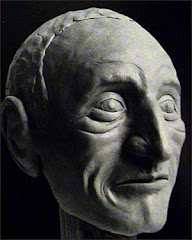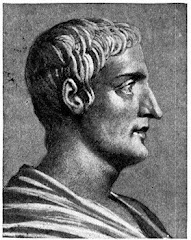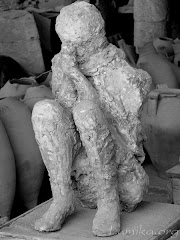Introduction
On August 24th, 79 AD, the people of Pompeii were doing the things they did normally on an average day. However, little did many people know that it would be their last day alive....
Pompeii
Basic History
Before AD 79, Pompeii was one of the richest cities in Italy, containing an amphitheatre, the Theatro Piccolo (Odeion), lots and lots of villas, barracks, over 25 street fountains, and even Public baths. It was conquered and reconquered several times, by the Etruscans, then the greek colony of Cumae with Syracuse, then by the Samnites, and finally by the powerful Romans. Pompeii received it's water from the 'Castellum Aquae' through an aqueduct which split into 3 main pipes.
At the time of the eruption, the city had around 20, 000 inhabitants.
Facts
-street graffiti already existed in Pompeii before the AD 79 eruption
- there was a form of Latin called 'vulgar latin', which was used in graffiti
-there was no word for 'Volcano' at the time
-there were bars, great food markets, mills, and a gymnasium
-studies in 2002 showed that the port was extremely populated and people lived in 'palafittes', within a system of channels similiar to that of Venice
-the city has moved inland, but at the time of the eruption, Pompeii was much closer to the sea
Before AD 79, Pompeii was one of the richest cities in Italy, containing an amphitheatre, the Theatro Piccolo (Odeion), lots and lots of villas, barracks, over 25 street fountains, and even Public baths. It was conquered and reconquered several times, by the Etruscans, then the greek colony of Cumae with Syracuse, then by the Samnites, and finally by the powerful Romans. Pompeii received it's water from the 'Castellum Aquae' through an aqueduct which split into 3 main pipes.
At the time of the eruption, the city had around 20, 000 inhabitants.
Facts
-street graffiti already existed in Pompeii before the AD 79 eruption
- there was a form of Latin called 'vulgar latin', which was used in graffiti
-there was no word for 'Volcano' at the time
-there were bars, great food markets, mills, and a gymnasium
-studies in 2002 showed that the port was extremely populated and people lived in 'palafittes', within a system of channels similiar to that of Venice
-the city has moved inland, but at the time of the eruption, Pompeii was much closer to the sea
What Happened?
IN the year AD79, the most terrible disaster in ancient history happened. It was the eruption of Mt. Vesuvius. On that fateful summers day, many civilians were minding their own business and doing their jobs. There were minor tremors all the morning, but no one cared, as it was quite often. However, according to Pliny the Younger, at noon, Mt. Vesuvius erupted.
First the black smoke had covered the entire sky, blotting out the sun. Next, pumice had started falling allong with some rocks. Afterwards, there were in all 3 pyroclastic surges. The cities of Herculaneum, Pompeii, and Stabiae were affected. Herculaneum was destroyed by a single pyroclastic surge.
Pompeii had survived one, but the last one had gone straight through it, across the bay of Naples, and damaged Miscenum.
Many people had hid in houses, but the weight of many pumices became too much for the weak wooden roofs, and fell down, crushing the inhabitants. Those who weren't crushed or incinerated had died of lack of oxygen and poisonous air. Most of our sources come from Pliny the Younger's eyewitness account of the eruption. Luckily, these sort of Plinian eruptions only happen about once every 2000 years.
First the black smoke had covered the entire sky, blotting out the sun. Next, pumice had started falling allong with some rocks. Afterwards, there were in all 3 pyroclastic surges. The cities of Herculaneum, Pompeii, and Stabiae were affected. Herculaneum was destroyed by a single pyroclastic surge.
Pompeii had survived one, but the last one had gone straight through it, across the bay of Naples, and damaged Miscenum.
Many people had hid in houses, but the weight of many pumices became too much for the weak wooden roofs, and fell down, crushing the inhabitants. Those who weren't crushed or incinerated had died of lack of oxygen and poisonous air. Most of our sources come from Pliny the Younger's eyewitness account of the eruption. Luckily, these sort of Plinian eruptions only happen about once every 2000 years.
Caius Julius Polybius: the wealthy merchant
This is the last day of Julius based on research findings.
Julius woke up early in A.D 79. He was very excited: some workers soon would arrive to repair some rooms in his house. He was very proud of himself. He went out the front door and looked at the wall. Some graffiti said: "The mule drivers ask you to elect Caius Julius Polybius as duovir." At approximately 65 years old, he was enjoying a luxurious life, holding the most important public office in Pompeii.
He went back in and walked through the house, admiring his treasure. The house was bustling. Women were already preparing a breakfast of honey doughnuts and a dish called 'garum', Julius' favourite dish.
In his garden, a tortoise was sleeping under a fig tree, undisturbed by Julius' grandson, who was climbing down a ladder holding a basketful of figs. The earth was shaking, but everyone ignored it. Earthquakes were very common in Pompeii. However, while eating breakfast, there was a huge roar, making the 12 inhabitants forget lunch. Pumice was falling everywhere, and the city was covered in smoke.
Julius tried to escape with his family, but a dead horse stopped their progress. They hid back in the house, and after what semmed like an eternity, a pyroclastic surge rushed through the streets the following day at 7 am, killing him and his family. At the garden, the tortoise withdrew his head for a last time.
Julius woke up early in A.D 79. He was very excited: some workers soon would arrive to repair some rooms in his house. He was very proud of himself. He went out the front door and looked at the wall. Some graffiti said: "The mule drivers ask you to elect Caius Julius Polybius as duovir." At approximately 65 years old, he was enjoying a luxurious life, holding the most important public office in Pompeii.
He went back in and walked through the house, admiring his treasure. The house was bustling. Women were already preparing a breakfast of honey doughnuts and a dish called 'garum', Julius' favourite dish.
In his garden, a tortoise was sleeping under a fig tree, undisturbed by Julius' grandson, who was climbing down a ladder holding a basketful of figs. The earth was shaking, but everyone ignored it. Earthquakes were very common in Pompeii. However, while eating breakfast, there was a huge roar, making the 12 inhabitants forget lunch. Pumice was falling everywhere, and the city was covered in smoke.
Julius tried to escape with his family, but a dead horse stopped their progress. They hid back in the house, and after what semmed like an eternity, a pyroclastic surge rushed through the streets the following day at 7 am, killing him and his family. At the garden, the tortoise withdrew his head for a last time.
Admiral Pliny
Pliny the elder was recently made admiral of the fleet, and resided in Miscenum, which was across the bay of Naples from Pompeii. When the eruption occured, Pliny decided to take a closer look at Vesuvius, because at heart he was a true studier of nature. However, just before he was about to leave, a messenger arrived at his palace from a friend that was stranded at the foot of Vesuvius. Pliny sent out many ships, but thanks to the falling pumice and black smoke, he was forced to travel down to Stabiae, where he recided at another friends house. However, before he was about to flee Stabiae with his friend, he saw a huge pyroclastic surge speeding down the mountain. He approached it, but died on the spot he stood on, due to the various gases of the pyroclastic surge. He didn't even bother to save himself......
Pliny the Younger
Pliny the younger went visiting his uncle, Admiral Pliny, with his mother. During the time of the eruption, he had refused to go out to sea with his uncle, and stayed at home watching the entire volcanic eruption. After a long while, he and his mother had fallen asleep on a chair. However, a great earthquake shook him onto the floor and so he requested his mother to follow him and leave the palace, but she wanted to wait for the return of Admiral Pliny. The earthquake had triggered a huge pyroclastic surge, which had kill Admiral Pliny, and the surge was headed towards Miscenum, and had travelled right across the Bay of Naples. This time, after realising the danger she was in, she finally left the palace with Pliny the younger just in time. Later on, Pliny the younger had written a description of the Pyroclastic surge so horrendously that no one had believed him about it. These days, people believe him, and call volcanic eruptions like the Vesuvius one 'Plinian'. It was thanks to Pliny the Younger that nowadays people can understand what happened at Popmeii, Herculaneum, Stabiae, and Miscenum.




